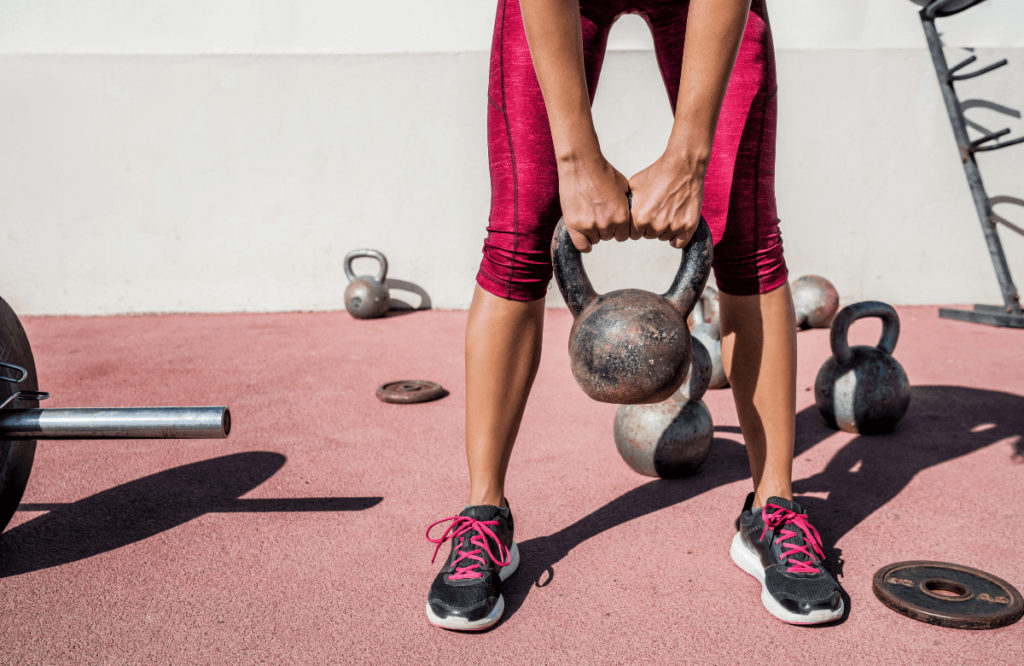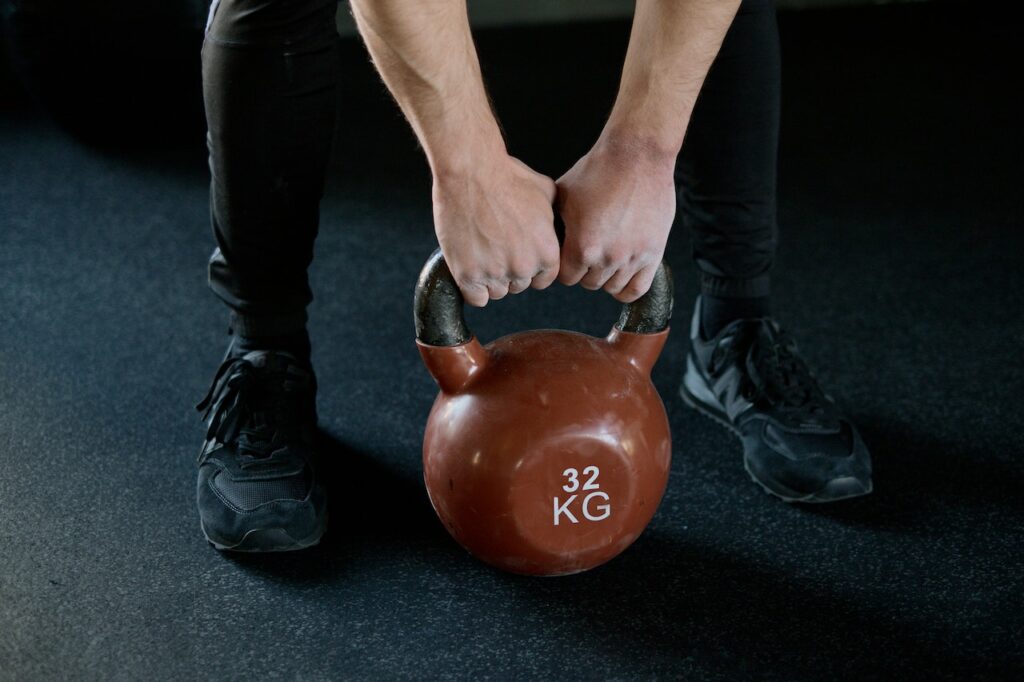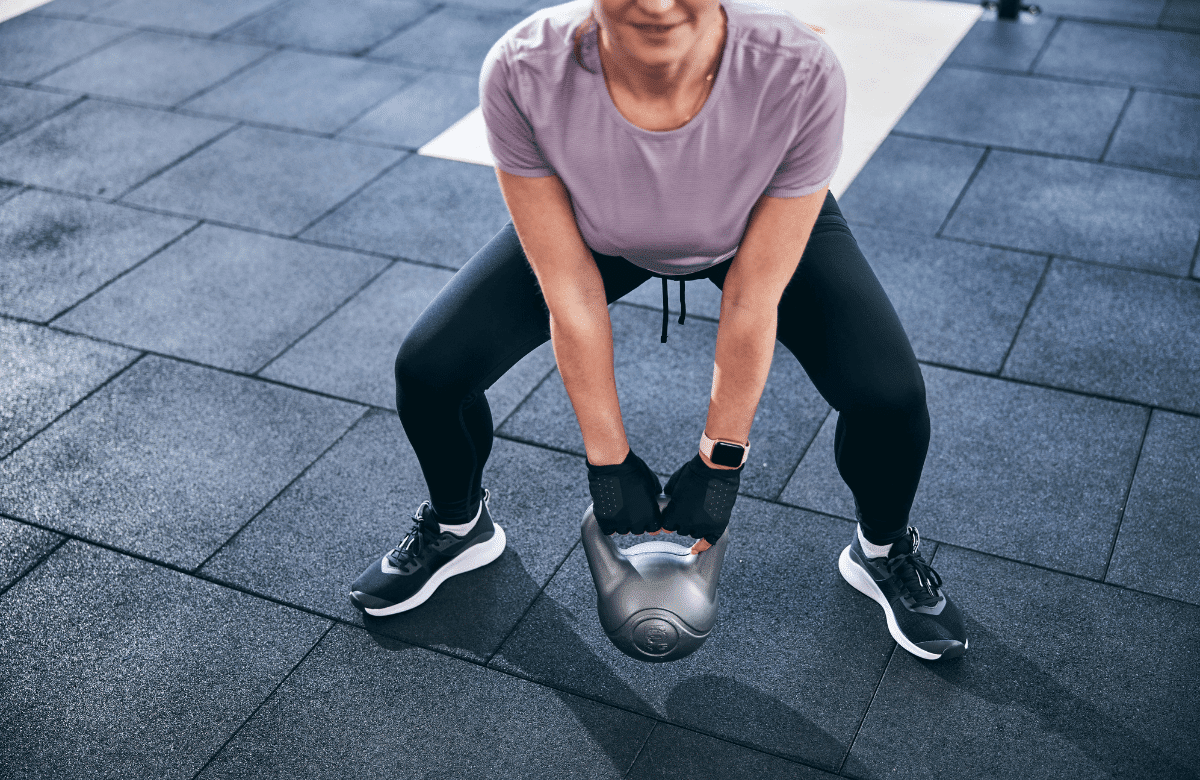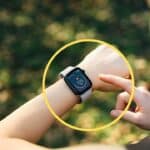If done with the correct form… The kettlebell deadlift can be an excellent posterior chain exercise that hits multiple different muscles throughout the body. If you’re new to the gym and looking for the best exercises to do, adding this one to your routine can help to build muscle, improve posture, and aid your balance.
It’s not just good for newbies, though. If you’re already killing it with the classic barbell deadlift, switching it out with a kettlebell deadlift variation every now and then can help to improve your posture and balance, as well as just change things up a little bit.
Here’s all you need to know about the kettlebell deadlift so you can start incorporating it into your routine and seeing the benefits!
Jump to:
- What is the Kettlebell Deadlift?
- Difference Between a Kettlebell Deadlift and a Regular Deadlift
- What Muscles Does the Kettlebell Deadlift Work?
- Benefits of the Kettlebell Deadlift
- Doing the Kettlebell Deadlift With Proper Form
- Kettlebell Deadlift Mistakes
- Kettlebell Deadlift Variations
- Tips for Success
What is the Kettlebell Deadlift?
The kettlebell deadlift is a variation of the conventional barbell deadlift that’s done using a single kettlebell instead of the usual barbell. It’s an excellent variation of a traditional compound exercise, so if you only have kettlebells, you don’t need to sacrifice your big lifts!
It’s usually performed in place of the regular deadlift. You don’t need to do this exercise if you’re already doing a normal deadlift in your routine, but it can be an excellent alternative for those who:
- Have injuries that make a normal deadlift difficult
- Want to try something different
- Only have access to kettlebells and no other weights

Difference Between a Kettlebell Deadlift and a Regular Deadlift
The most obvious difference is that the conventional deadlift is done with a barbell and weights, while the kettlebell deadlift is done using a kettlebell! For newbies, you may want to start with the kettlebell deadlift and progress to a regular deadlift later when you’re comfortable with the basic hip hinge movement.
While both versions work mostly the same muscles, there are some important differences between the two, including:
Grip & Position
Your regular deadlift can be done with an overhand grip, an underhand grip, or a mixed grip. But the kettlebell deadlift doesn’t usually deviate from the regular overhand grip position.
Also, the normal deadlift grip has your hands on the outside of your legs, the kettlebell deadlift keeps your hands between your knees.
You may need to use a slightly wider stance than the conventional deadlift stance to accommodate the hand position for the KB deadlift.
Weight Used
Typically, you won’t be lifting as much weight with the kettlebell as you would with the barbell. The extra load is also distributed differently, centered in the middle rather than across the bar, which can make the load feel a little heavier. So don’t try to choose a heavy kettlebell to match your barbell deadlifts—go for a lighter kettlebell from the start.
What Muscles Does the Kettlebell Deadlift Work?
The traditional deadlift and the kettlebell deadlift work many of the same muscles. Whichever one you do, the movement works the posterior chain, which includes the hamstrings, glutes, calves, and the upper back muscles, including the lats, rear delts, and even the erector spinae muscles.
While the hamstrings and glutes get the best workout, the quads also get a pretty decent activation. If you’re feeling it more in your quads than your hamstrings, though, you may be squatting too low during the movement.
One of the things the kettlebell deadlift works that the regular movement doesn’t is the adductors. These are muscles on the inner thigh, which you’re unlikely to hit when your hands are placed on the outside of your knees during a traditional deadlift movement.
Other muscles you can expect to get a good workout include the obliques and abs, as the entire core braces during the movement, and the forearms, as you flex them to keep a good grip on the weight during the exercise

Benefits of the Kettlebell Deadlift
The kettlebell deadlift is one of the best compound exercises you can do! This simple movement offers multiple benefits, including the ones below.
Excellent Muscle Builder
The deadlifting movement is a great compound exercise that hits multiple muscles at a time. That’s why it’s a firm favorite amongst bodybuilders! You can build an impressive set of legs and a muscular back by doing the deadlift correctly.
Aside from the posterior chain, the kettlebell deadlift is an excellent exercise for core strength. As you perform the movement, you should be tensing your core to keep the correct posture, which works all those muscles.
Building muscle mass comes with another benefit—an increased metabolic rate, leading to more calories burned throughout the day at rest. While the kettlebell exercise itself may not burn a ton of calories with the motion, it can definitely contribute to burning more calories in the long run!
Strengthens Posterior Chain
A strong posterior chain is essential for life! This group of muscles is responsible for your posture. When they’re weak, you’re much more at risk for back pain, neck pain, and a hunched over posture.
With a weak posterior chain, everyday movements like bending and straightening can become more difficult. Even if they don’t feel hard, other muscles will end up compensating and you’re more likely to tweak something!
The kettlebell deadlift is an excellent exercise for building a strong posterior chain. It targets all the muscles down the back of your body, which means every time you do this exercise, you’re building a stronger, more protective posterior chain.
Improves Posture & Balance
With a strong posterior chain comes improved posture. You’ll find yourself standing taller, sitting straighter, and ultimately, this will lead to a healthier back and neck.
Better posture also improves your balance. Balance is an important thing, and we don’t tend to think about it until it starts affecting daily movements. By strengthening the posterior chain, you can get ahead of potential balance problems.
Increases Bone Density
This is a benefit that most people don’t realize comes with the kettlebell deadlift! It’s a known fact that weightlifting increases bone density, and the deadlift is one of the best compound exercises you can choose to do.
Increased bone density is hugely beneficial, especially as we age. Good bone density means fewer fractures over time and an excellent range of motion as we grow older.

Doing the Kettlebell Deadlift With Proper Form
So now that we know kettlebell deadlifts are an amazing exercise. But of course, an exercise is only beneficial if it’s done with proper form—get your form wrong, and you’ll be on track to hurting yourself, perhaps permanently.
Here’s how to do a kettlebell deadlift the right way. It may take some practice, and we recommend doing it slowly and carefully until you’re familiar with the movement. After a few weeks of mindful lifting, you should find that it becomes muscle memory!
However, it’s still a good idea to pay attention to your form on a daily basis as you do each exercise. Bad form is a gateway to injury!
Grip
Your deadlift is only as good as your grip! You’ll have both hands on the top of the kettlebell handle, next to each other with palms facing down. You want a firm grip on the kettlebell, but not so hard that your hands begin to cramp.
If you struggle with sweaty hands ruining your grip strength, we recommend either investing in quality gym gloves, or buying some chalk to absorb the sweat on your hands.
Stance
Getting yourself in the correct stance is the first step to performing a successful deadlift. Have your feet shoulder width apart, toes facing as forward as you can get them. Make sure your weight is evenly distributed across your feet, and your feet are as flat as possible on the ground.
Place the kettlebell on the ground in between your feet. From your standing position, you want to hinge at the waist, bending your knees and pushing your butt backwards. Lower your hands towards the kettlebell so you can grab it.
It’s essential to make sure that your back stays straight and doesn’t flex or round! When you have a good grip on the kettlebell, readjust yourself slightly so that your upper body is at around a 45-degree angle. This is your starting point.
The Lift
From your starting position, before you even move, brace your core. This basically means tightening your core muscles in preparation for movement!
From there, engage your glutes to stand up straight. This is important! You don’t want to push with the quads, or stretch your back while you’re standing up. Your hips should hinge backwards slightly, bringing your upper body to a straight, standing position. Give the glutes an extra squeeze when they’re locked out!
Don’t manhandle the kettlebell around—let it move naturally with your grip, which should keep it close to the body. It’s also extremely important to keep the core tight and keep the back straight throughout the movement.

Kettlebell Deadlift Mistakes
There are the most common mistakes we see people making with the kettlebell deadlift. Pay attention to these when you’re doing it and make sure you’re not falling victim to them!
Using the Wrong Weight
It’s tempting to use a kettlebell that’s the same weight as your barbell. But because the weight is distributed quite differently, it’s in your best interest to start with something quite a bit lighter—don’t just go for a heavy weight out of the gates.
Rounding the Back
Rounding the back can happen even without you noticing. Maintaining a neutral spine throughout the movement is essential, or it will be ineffective and you’ll be more at risk of injuring yourself!
Pay close attention to your back during the movement and make sure it stays straight. If you can’t quite tell, slow the movement down and focus on the back as you perform the movement, making sure it doesn’t round.
Overextending the Back
Almost the opposite problem, another common mistake is rounding the back when you get to the top of the movement. Some people end up leaning over towards the back when they stand up, which can lead to injury.
You should be squeezing your glutes to get you up to the top of the movement. You shouldn’t be using your back muscles to lift or pull, but rather to stabilize your core.
Stand up straight with no overextending the back—imagine a string coming out of your head, pulling you up to the ceiling. No arching the back!
Not Squeezing the Glutes
You’d be surprised at how many people forget to squeeze the glutes! You’ll use your glutes to help push you up to the standing position, where you should be giving them a good squeeze to activate the muscles and engage the whole posterior chain.
Forget to squeeze the glutes, and you may end up activating all the wrong muscles! You’ll still be able to do the exercise, but it won’t be as effective, and you’ll be more prone to becoming injured.
Not Keeping the Core Tight
A floppy core means poor form. It’s important to keep your core engaged during the movement, as it helps to keep a straight spine. Of course, activating your core muscles also gives them a bit of a workout and can contribute to developing good abs!
Poor Grip
This can go two ways. One, you might not be gripping hard enough, especially if you’re using a heavier kettlebell. This can ruin the movement, so if this sounds like something you struggle with, it’s a good idea to use a wrist strap to help you get a good grip.
On the other hand, you don’t want to be grabbing it too tight. If you do, your forearms are going to tire out before the rest of your muscles do, so you won’t get as good a workout as you should. This can also be helped with wrist straps, as it takes some pressure off the hands.
Too Much Quad Engagement
Don’t squat too far down before coming up on the deadlift. If your butt is too far down, you may end up squatting the weight upwards instead of lifting it using the posterior chain muscles, which means your quads will be getting a monster workout but your back, hamstrings, and glutes won’t be.
Fix this by fixing your form. Hinge at the hips, around 45 degrees. Then lower yourself, bending your knees slightly, to grab the kettle bell. Avoid bending the knees too much so you land in a squat position!

Kettlebell Deadlift Variations
The kettlebell deadlift is actually pretty versatile! Here are a few different variations on the standard version. You can experiment with different types of deadlifts and switch it up here and there to stay interested and hit all the right muscles.
Double Kettlebell Deadlift
Holding a kettlebell in each hand allows you to deadlift with a neutral grip—similar to trap bar deadlifts. This variation can be helpful for those who have less wrist mobility, and you can also use a narrower stance and place the kettlebells on the outside of your feet.
Sumo Deadlift
The kettlebell sumo deadlift—both barbell and kettlebell—uses a much wider stance than regular ones. This places a bit more emphasis on the inner and outer thighs, whale really nailing the glutes as well.
It’s basically the same concept as the normal deadlift, just with wider foot placement. Start with your usual deadlift stance, and then take a smallish step to either side with each foot. Your feet should be about 1 ½ times shoulder width apart.
From there, perform the kettlebell deadlift like you normally would. You should notice the muscles in your thighs activating.
You can also do this with two separate kettlebells if that feels better for you. Make sure to keep the back straight and tighten the core so you don’t lose your balance!
RDL (Romanian Deadlift)
In this version of the deadlift, bring your feet closer together so there’s less space between them. You should also take care to not bend the legs as much as usual—you should hinge further at the hips instead, to grip your kettlebell during your RDLs.
You’ll have no choice but to engage the glutes to come back up, as there’s no push from the legs. This variation places a much higher load on the glutes, hamstrings, and lower back. But make sure to do it right to avoid hurting yourself!
Single-Leg Deadlift
A single-leg deadlift kettlebell is a nice variation to have in your arsenal. Place the kettlebell in front of one foot. This will be the leg you’re deadlifting on. Bend to grip the kettlebell, and shift your weight onto that leg. Extend your other leg out behind you to help you balance.
Make sure your back is straight and not rounded. Like a normal deadlift, squeeze the glutes and hinge upwards at the hips to stand up. Don’t put your other foot on the ground—you will end up lowering your back leg, but keep it just next to your planted leg before you go back down into another single-leg deadlift.
As a variation on this variation, you can grip the kettlebell with just one hand and extend the other one out to the side for better balance. You can also do a single-leg kettlebell Romanian deadlift.
Tips for Success
Always Warm Up
Warming up is essential when you’re doing an exercise that involves large muscle groups like the kettlebell deadlift. You don’t need to do a lot—just some dynamic stretches to get your muscles warm and ready for hard work.
Keep Your Form
Throughout the movement, be mindful of your form. You should be keeping it perfect all the way through the exercise—and if you lose your form, take a break instead of trying to push through it. If you can’t keep good form for more than a few reps, you may be using a weight that’s too heavy.
Ease Into It
Start with a light weight—lighter than you think you’ll need. You should be able to do 4 to 6 reps with excellent form (for the men) and 8 to 10 reps (for women). If you can’t do 4/8 reps with the right form, lower the weight. Once you’ve hit those numbers, work with that weight until you reach 6/10, when you can increase to a slightly heavier weight.
Deadlift In a Mirror
If possible, try to deadlift in front of a mirror. If the mirror is in front of you, you should be able to see if your form is going off anywhere. Don’t try to look into a mirror that’s next to you, though, because you can place strain on your neck and upper back and do the movement wrong.
If you don’t have a mirror, you can always video yourself doing deadlifts, from front and side. Watch them afterwards, and spot any small niggles that should be worked on.
Mastering the kettlebell deadlift is something every gym goer should work on. It’s an excellent exercise that works multiple major muscle groups, and trust us, once you get it right, you’ll be able to feel it working on those muscles!
It’s extremely important to get your form right, but as long as you do that, you can look forward to immense gains from learning this one simple movement.















